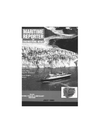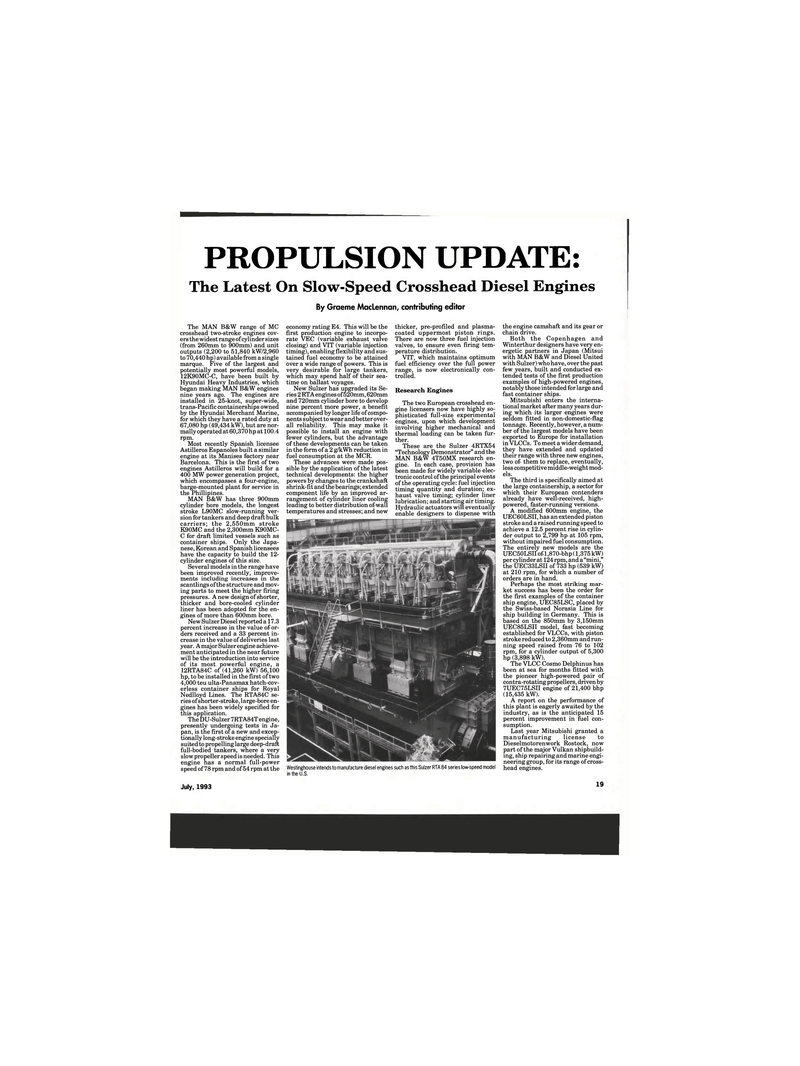
Page 17: of Maritime Reporter Magazine (July 1993)
Read this page in Pdf, Flash or Html5 edition of July 1993 Maritime Reporter Magazine
PROPULSION UPDATE:
The Latest On Slow-Speed Crosshead Diesel Engines
By Graeme MacLennan, contributing editor
The MAN B&W range of MC crosshead two-stroke engines cov- ers the widest range of cylinder sizes (from 260mm to 900mm) and unit outputs (2,200 to 51,840 kW/2,960 to 70,440 hp) available from a single marque. Five of the largest and potentially most powerful models, 12K90MC-C, have been built by
Hyundai Heavy Industries, which began making MAN B&W engines nine years ago. The engines are installed in 25-knot, super-wide, trans-Pacific containerships owned by the Hyundai Merchant Marine, for which they have a rated duty at 67,080 hp (49,434 kW), but are nor- mally operated at 60,370 hp at 100.4 rpm.
Most recently Spanish licensee
Astilleros Espanoles built a similar engine at its Manises factory near
Barcelona. This is the first of two engines Astilleros will build for a 400 MW power generation project, which encompasses a four-engine, barge-mounted plant for service in the Phillipines.
MAN B&W has three 900mm cylinder bore models, the longest stroke L90MC slow-running ver- sion for tankers and deep draft bulk carriers; the 2,550mm stroke
K90MC and the 2,300mm K90MC-
C for draft limited vessels such as container ships. Only the Japa- nese, Korean and Spanish licensees have the capacity to build the 12- cylinder engines of this size.
Several models in the range have been improved recently, improve- ments including increases in the scantlings of the structure and mov- ing parts to meet the higher firing pressures. A new design of shorter, thicker and bore-cooled cylinder liner has been adopted for the en- gines of more than 600mm bore.
New Sulzer Diesel reported a 17.3 percent increase in the value of or- ders received and a 33 percent in- crease in the value of deliveries last year. A major Sulzer engine achieve- ment anticipated in the near future will be the introduction into service of its most powerful engine, a 12RTA84C of (41,260 kW) 56,100 hp, to be installed in the first of two 4,000 teu ulta-Panamax hatch-cov- erless container ships for Royal
Nedlloyd Lines. The RTA84C se- ries of shorter-stroke, large-bore en- gines has been widely specified for this application.
The DU-Sulzer 7RTA84T engine, presently undergoing tests in Ja- pan, is the first of a new and excep- tionally long-stroke engine specially suited to propelling large deep-draft full-bodied tankers, where a very slow propeller speed is needed. This engine has a normal full-power speed of 78 rpm and of 54 rpm at the economy rating E4. This will be the first production engine to incorpo- rate VEC (variable exhaust valve closing) and VIT (variable injection timing), enabling flexibility and sus- tained fuel economy to be attained over a wide range of powers. This is very desirable for large tankers, which may spend half of their sea- time on ballast voyages.
New Sulzer has upgraded its Se- ries 2 RTA engines of520mm, 620mm and 720mm cylinder bore to develop nine percent more power, a benefit accompanied by longer life of compo- nents subject to wear and better over- all reliability. This may make it possible to install an engine with fewer cylinders, but the advantage of these developments can be taken in the form of a 2 g/kWh reduction in fuel consumption at the MCR.
These advances were made pos- sible by the application of the latest technical developments: the higher powers by changes to the crankshaft shrink-fit and the bearings; extended component life by an improved ar- rangement of cylinder liner cooling leading to better distribution of wall temperatures and stresses; and new thicker, pre-profiled and plasma- coated uppermost piston rings.
There are now three fuel injection valves, to ensure even firing tem- perature distribution.
VIT, which maintains optimum fuel efficiency over the full power range, is now electronically con- trolled.
Research Engines
The two European crosshead en- gine licensers now have highly so- phisticated full-size experimental engines, upon which development involving higher mechanical and thermal loading can be taken fur- ther.
These are the Sulzer 4RTX54 "Technology Demonstrator" and the
MAN B&W 4T50MX research en- gine. In each case, provision has been made for widely variable elec- tronic control of the principal events of the operating cycle: fuel injection timing quantity and duration; ex- haust valve timing; cylinder liner lubrication; and starting air timing.
Hydraulic actuators will eventually enable designers to dispense with the engine camshaft and its gear or chain drive.
Both the Copenhagen and
Winterthur designers have very en- ergetic partners in Japan (Mitsui with MAN B&W and Diesel United with Sulzer) who have, over the past few years, built and conducted ex- tended tests of the first production examples of high-powered engines, notably those intended for large and fast container ships.
Mitsubishi enters the interna- tional market after many years dur- ing which its larger engines were seldom fitted in non-domestic-flag tonnage. Recently, however, a num- ber of the largest models have been exported to Europe for installation in VLCCs. To meet a wider demand, they have extended and updated their range with three new engines, two of them to replace, eventually, less competitive middle-weight mod- els.
The third is specifically aimed at the large container ship, a sector for which their European contenders already have well-received, high- powered, faster-running versions.
A modified 600mm engine, the
UEC60LSII, has an extended piston stroke and a raised running speed to achieve a 12.5 percent rise in cylin- der output to 2,799 hp at 105 rpm, without impaired fuel consumption.
The entirely new models are the
UEC50LSII of 1,870-bhp (1,375 kW) per cylinder at 124 rpm, and a "mini," the UEC33LSII of 733 hp (539 kW) at 210 rpm, for which a number of orders are in hand.
Perhaps the most striking mar- ket success has been the order for the first examples of the container ship engine, UEC85LSC, placed by the Swiss-based Norasia Line for ship building in Germany. This is based on the 850mm by 3,150mm
UEC85LSII model, fast becoming established for VLCCs, with piston stroke reduced to 2,360mm and run- ning speed raised from 76 to 102 rpm, for a cylinder output of 5,300 hp (3,898 kW).
The VLCC Cosmo Delphinus has been at sea for months fitted with the pioneer high-powered pair of contra-rotating propellers, driven by 7UEC75LSII engine of 21,400 bhp (15,435 kW).
A report on the performance of this plant is eagerly awaited by the industry, as is the anticipated 15 percent improvement in fuel con- sumption.
Last year Mitsubishi granted a manufacturing license to
Dieselmotorenwork Rostock, now part of the major Vulkan shipbuild- ing, ship repairing and marine engi- neering group, for its range of cross- head engines. Westinghouse intends to manufacture diesel engines such as this Sulzer RTA 84 series low-speed model in the U.S.
July, 1993 19

 16
16

 18
18
